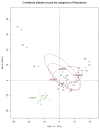Characterizing and contrasting the microbial ecology of laboratory and full-scale EBPR systems cultured on synthetic and real wastewaters
- PMID: 27814897
- PMCID: PMC5176642
- DOI: 10.1016/j.watres.2016.10.069
Characterizing and contrasting the microbial ecology of laboratory and full-scale EBPR systems cultured on synthetic and real wastewaters
Abstract
The anthropogenic discharge of phosphorus (P) into surface waters can induce the proliferation of cyanobacteria and algae, which can negatively impact water quality. Enhanced biological P removal (EBPR) is an engineered process that can be employed to efficiently remove significant quantities of P from wastewater. Within this engineered system, the mixed microbial consortium (MMC) becomes enriched with polyphosphate accumulating organisms (PAOs). To date much knowledge has been developed on PAOs, and the EBPR process is generally well understood; nonetheless, the engineered process remains underutilized. In this study, investigations were conducted using qPCR and Illumina MiSeq to assess the impacts of wastewater (synthetic vs. real) on EBPR microbial ecology. While a strong relationship was demonstrated between EBPR metrics (P:C; influent VFA:P) and excellent P removal across diverse EBPR systems and MMCs, no such correlations existed with the specific MMCs. Moreover, MMCs exhibited distinct clusters based on substrate, and qPCR results based on the putative PAO Accumulibacter did not correlate with BLASTN eubacterial results for either Accumulibacter or Rhodocyclaceae. More critically, PAO-based sequences aligned poorly with Accumulibacter for both eubacterial and PAO primer sets, which strongly suggests that the conventional PAO primers applied in FISH and qPCR analysis do not sufficiently target the putative PAO Accumulibacter. In particular, negligible alignment was observed for PAO amplicons obtained from a MMC performing excellent EBPR on crude glycerol (an atypical substrate). A synthetic wastewater-based MMC exhibited the best observed BLASTN match of the PAO amplicons, raising concerns about the potential relevance in using synthetic substrates in the study of EBPR.
Keywords: Accumulibacter; Crude glycerol; Enhanced biological phosphorus removal, EBPR; Illumina MiSeq; Phosphorus accumulating organisms, PAOs; Volatile fatty acids, VFAs; qPCR.
Copyright © 2016 Elsevier Ltd. All rights reserved.
Figures




Similar articles
-
Polyphosphate-accumulating organisms in full-scale tropical wastewater treatment plants use diverse carbon sources.Water Res. 2019 Feb 1;149:496-510. doi: 10.1016/j.watres.2018.11.011. Epub 2018 Nov 9. Water Res. 2019. PMID: 30476778
-
Accumulibacter diversity at the sub-clade level impacts enhanced biological phosphorus removal performance.Water Res. 2021 Jul 1;199:117210. doi: 10.1016/j.watres.2021.117210. Epub 2021 May 5. Water Res. 2021. PMID: 34004444
-
Side-stream enhanced biological phosphorus removal (S2EBPR) process improves system performance - A full-scale comparative study.Water Res. 2019 Dec 15;167:115109. doi: 10.1016/j.watres.2019.115109. Epub 2019 Sep 23. Water Res. 2019. PMID: 31585384
-
Enhanced biological phosphorus removal with different carbon sources.Appl Microbiol Biotechnol. 2016 Jun;100(11):4735-45. doi: 10.1007/s00253-016-7518-4. Epub 2016 Apr 18. Appl Microbiol Biotechnol. 2016. PMID: 27087523 Review.
-
Enhanced Bio-P removal: Past, present, and future - A comprehensive review.Chemosphere. 2022 Dec;309(Pt 2):136518. doi: 10.1016/j.chemosphere.2022.136518. Epub 2022 Sep 30. Chemosphere. 2022. PMID: 36191763 Review.
Cited by
-
Unlocking the potential of sidestream EBPR: exploring the coexistence of PAO, GAO and DGAO for effective phosphorus and nitrogen removal.Water Sci Technol. 2025 Mar;91(5):469-481. doi: 10.2166/wst.2025.038. Epub 2025 Mar 6. Water Sci Technol. 2025. PMID: 40087960
-
The PolS-PolR Two-Component System Regulates Genes Involved in Poly-P Metabolism and Phosphate Transport in Microlunatus phosphovorus.Front Microbiol. 2019 Sep 13;10:2127. doi: 10.3389/fmicb.2019.02127. eCollection 2019. Front Microbiol. 2019. PMID: 31572333 Free PMC article.
References
-
- Al-Najjar MM, Coats ER, Loge FJ. The role of the microbial stringent response in excess intracellular accumulation of phosphorous in mixed consortia fed synthetic wastewater. Water Res. 2011;45(16):5038–5046. - PubMed
MeSH terms
Substances
Grants and funding
LinkOut - more resources
Full Text Sources
Other Literature Sources

